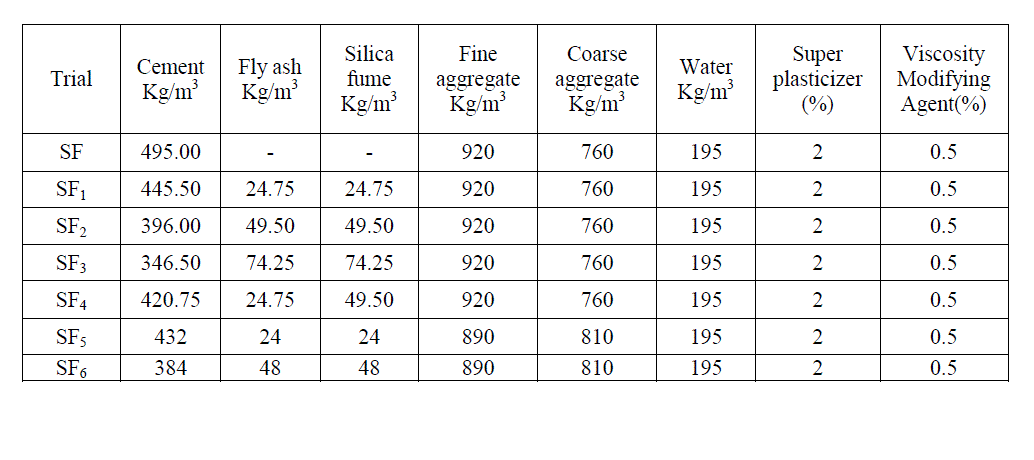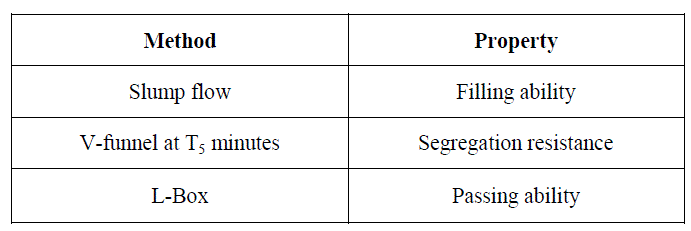ISSN ONLINE(2319-8753)PRINT(2347-6710)
ISSN ONLINE(2319-8753)PRINT(2347-6710)
A.Deepika1, Dr S.Krishnamoorthi2, G.S.Rampradheep3
|
| Related article at Pubmed, Scholar Google |
Visit for more related articles at International Journal of Innovative Research in Science, Engineering and Technology
Self-Consolidating Concrete (SCC) is an innovative concrete that does not require vibration for placing and compaction. It is able to flow under its own weight, completely filling formwork and achieving full compaction, even in the presence of congested reinforcement. Self-Consolidating Concrete has properties that differ considerably from conventional concrete. This paper investigates the workability properties of Self-Consolidating Concrete containing fly ash and silica fume with super plasticizer and viscosity modifying agent. Conplast SP 337 was used as super plasticizer and Glenium Stream 2 was used as Viscosity modifying agent. The SCC trials were made as per EFNARC Specifications. In this paper trials were made at varying replacement levels (10%, 20%, 30%) of fly ash and silica fume. The workability properties of SCC such as filling ability, passing ability and segregation resistance are evaluated using workability tests such as slump flow, V-funnel and L-Box tests. The compressive strength of the cubes at 7 days, 28 days are also obtained and it was found that the mix have good compressive strength at 10% replacement.
Keywords |
| Self–Consolidating Concrete, fly ash, silica fume, workability. |
INTRODUCTION |
| Concrete technology has made massive development in the past decade. Now a day’s concrete is not a material that consist only cement, fine aggregate, coarse aggregate and water but it is an engineered material that consists of many new materials which performs satisfactorily under all conditions. The modern concrete consists of various filler materials such as fly ash, micro silica, GGBS etc. The development of Self-Consolidating Concrete (SCC) has recently been one of the most important developments in the building industry. The purpose of this concrete concept is to decrease the risk due to the human factor, to enable the economic efficiency, more freedom to designers and constructors and more human work. There is no standard method for SCC mix design and many academic institutions, ready-mixed, precast and contracting companies have developed their own mix proportioning methods. Mix designs often use volume as a key parameter because of the importance of the need to over fill the voids between the aggregate particles. |
| The Self-Consolidating Concrete is a concrete which flows and settles due to its own weight without segregation and bleeding. SCC has several advantages over normal conventional concrete. It can flow easily in congested reinforced areas such as in beam column joints. Self-Consolidating Concrete was developed at the time to improve the durability of concrete structures. Since then, various investigations have been carried out and SCC has been used in practical structures in Japan, mainly by large construction companies. Investigations for establishing a rational-mix design method and Self-Consolidating testing methods have been carried out from the viewpoint of making it a standard concrete. In Self-Consolidating Concrete, no additional inner or outer vibration is necessary for the compaction. It flows like “honey” and has a very smooth surface level after placing. With regard to its composition, Self- Consolidating Concrete consists of the same components as conventionally vibrated concrete, which are cement, aggregates and water, with the addition of chemical and mineral admixtures in different proportions. Admixtures are materials that are added to concrete mix other than cement and aggregates to improve the desirable properties of cement without having any adverse effect on the properties of the mix. Usually, the chemical admixtures used are High-Range Water Reducers (super plasticizers) and Viscosity Modifying Agents, which change the rheological properties of concrete. |
| Mineral admixtures such as fly ash and silica fume are used and its effect on fresh properties of self-consolidating concrete was evaluated. The fibre reinforced concrete shows many improvements in the properties of normal conventional concrete. The increased ductility is due to the ability of the fibres to transfer tensile stresses across a cracked section, potentially leading to a reduction in crack widths. In this study stainless steel fibre and nylon fibres are used and the influence of fibres in fresh properties of self-consolidating concrete was evaluated. |
II. LITERATURE REVIEW |
| Prajapati Krishnapal et.al. had studied the rheological properties of self compacting concrete containing fly ash. In this paper the properties of self compacting concrete with different percentages of fly ash (0%, 10%, 20%, 30%) as partial replacement of cement was studied. The workability characteristics like filling ability, passing ability have been assessed using slump flow and T50 time, V Funnel time, L-Box blocking ratio, as per EFNARC Guidelines. This paper concludes that the flow property of concrete increases with the increase in percentage of fly ash, the passing ability of the concrete also increases and also the addition of fly ash shows better workability for same water cement ratio without any adverse effect on the strength of concrete. Ganeshwaran.P.A et.al. had evaluated the Mechanical Properties of Self Compacting Concrete with Manufactured Sand and Fly Ash. SCC containing different proportion of fly ash have been tested for Slump flow, V-funnel, U-Box, L-box and J-ring and found that the values are within the limits prescribed by EFNARC.Mechanical properties such as compressive strength, split tensile strengthhave been evaluated as per Bureau of Indian Standards. It is observed from the studies that the compressive strength and split tensile strength decreases with the increase in replacement of cement by fly ash. It was concluded that SCC with manufactured sand and fly ash can be used for all applications in the construction sector. Prashant Bhuva et.al. had studied about the development of Self- Compacting Concrete using different range of cement content. For the development of Self Compacting Concrete no Specific Method of Mix Design is Available. In this paper an attempt is made to develop SCC of different strength by using various ranges of cements and Fly Ash, with appropriate quantity of Super plasticizer and VMA. From the marsh cone test conducted for different dosage of Super Plasticizer, it is observed that the optimum dosage of Super Plasticizer is 0.8% of Cementitious material is the saturated point, and with further increase in the percentage of Super Plasticizer, there is no effect in the flowability is noted. Further it was concluded from rebound hammer test that, trial mixes having higher Cementitious material give higher compressive strength. Kandasamy.R et.al. had investigated the properties of Fibre Reinforced concrete using domestic waste plastics as fibres. The addition of steel fibre increases the properties of concrete, viz., flexural strength, impact strength and shrinkage properties to name a few. A number of papers have already been published on the use of steel fibres in concrete and a considerable amount of research has been directed towards studying the various properties of concrete as well as reinforced concrete due to the addition of steel fibres. Hence, an attempt has been made in the present investigations to study the influence of addition of polythene fibers (domestic waste plastics) at a dosage of 0.5% by weight of cement. The properties studied include compressive strength and flexural strength. The studies were conducted on a M20 mix and tests have been carried out as per recommended procedures of relevant codes. It was concluded that the cube compressive strength of concrete in 7 days to an extent of 0.68% and also the split tensile strength increases upto 1.63%. |
III. MATERIAL PROPERTIES |
| Cement: Ordinary Portland cement of 53 grades (Zuari Cement) conforming to IS 8112-1989 was used. |
| Fine Aggregate: Natural fine aggregate (conforming to grading zone II of IS 383-1970 ) available in local market having specific gravity 2.60 was used. |
| Coarse Aggregate: Normal coarse aggregate of size 12.5 mm, having specific gravity 2.62 was used. |
| Silica Fume: Silica fume available in local market having specific gravity 2.2 is used as a partial replacement material for cement. |
| Fly Ash: Fly ash conforming to class F was used as partial replacement for cement. |
| Water: Fresh, colourless, odourless and tasteless potable water having pH value ranging between 6 to 8 was used. |
| Super plasticizer: Conplast SP 337, brown colour chloride free liquid having specific gravity 1.18 was used. |
| Super plasticizer: Conplast SP 337, brown colour chloride free liquid having specific gravity 1.18 was used. |
| Viscosity Modifying Agent: Glenium Stream 2, colourless free flowing liquid was used. |
IV. MIX DESIGN DATA |
| The trial mix design of self-consolidating concrete with various percentages of fly ash and silica fume based on European Federation for Specialist Construction Chemicals and Concrete Systems (EFNARC) are given in Table 1. |
 |
RESULTS |
| The main characteristics of Self-Consolidating Concrete are the properties in the fresh state. The mix design is focused on the ability to flow under its own weight without vibration, the ability to flow through heavily congested reinforcement under its own weight, and the ability to retain homogeneity without segregation. The workability of Self- Consolidating Concrete is higher than “very high” degree of workability mentioned in IS 456:2000. |
| A concrete mix can only be classified as Self-Consolidating Concrete if it has the following characteristics. |
| ïÃâ÷ Filling ability |
| ïÃâ÷ Passing ability |
| ïÃâ÷ Segregation resistance |
| Several test methods have been developed in attempts to characterize the properties of Self-Consolidating Concrete. In this study three methods are used to evaluate the fresh properties of Self-Consolidating Concrete.Each method has its different property and listed in table 2. |
 |
| The workability properties should satisfy the permissible limit .the various trial values are evaluated by slump flow (650-800)mm, V-funnel (8-12)sec and L-box (0.8-1.0) in table 3. |
 |
| The results of various SCC trial mixes are summarized in table 3 and table 4. |
| In the present investigation the cement is replaced equally by fly ash and silica fume up to 30%(10%,20%,30%,15%) by weight of cement. The total powder content of the trials is taken as 495 kg/m3 and 480 kg/m3 respectively. The trial mixes are prepared based on EFNARC Specifications. The slump flow increases from 650mm -700mm, these results are within the prescribed limits of EFNARC guidelines. The V-funnel time limits should range between 8-12 seconds as per EFNARC specifications, the test results are satisfying that specifications. In L-Box, the blocking ratio should range between 0.8-1.0 as per EFNARC, most of the trials satisfy the criteria and this show that the concrete mix have good passing ability. Further the compressive strength of the mix decreases with the increase in replacement percentage of fly ash and silica fume as shown in fig.2. |
VI. CONCLUSION |
| In this study seven trail mixes of self-consolidating concrete were designed and its fresh state properties such as slump flow test, V-funnel test and L-box test were evaluated as per EFNARC guidelines. At various percentages of replacement levels of fly ash and silica fume content, the workability criteria are satisfied at same percentage of super plasticizer and Viscosity Modifying agents. At 10% replacement level the mix have good compressive strength (43.5 N/mm2) compared to 20%, 30% replacement levels. The compressive strength of strength of the mix decreases with the increase in replacement percentage of the admixtures. It was concluded that it is possible to produce Self-consolidating concrete using Fly ash and silica fume at 10% replacement of Fly ash and silica fume by weight of cement. |
References |
|